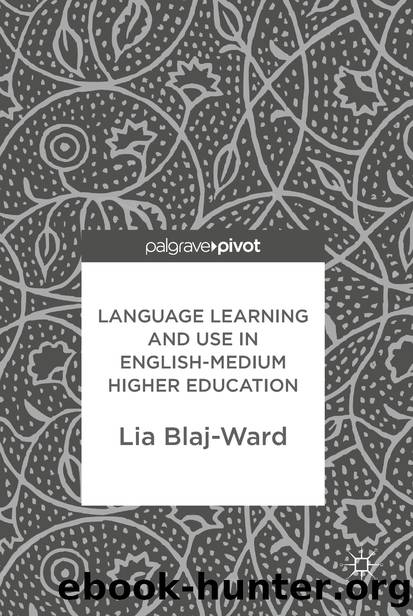Language Learning and Use in English-Medium Higher Education by Lia Blaj-Ward

Author:Lia Blaj-Ward
Language: eng
Format: epub
Publisher: Springer International Publishing, Cham
4.4 Olivia
Olivia’s experience with spoken English while an undergraduate exchange student in the UK resonated with that of both AcLitT and 3LU participants and helped highlight some key aspects that language proficiency studies overlook: managing the emotional aspects of language use and engaging in reflection about one’s development as a language user. At the beginning of her one-year stay, as recounted in Chap. 2, Olivia almost left the room during a social lunch organised to give the students the opportunity to meet their peers and design tutors. During the initial stage, Olivia felt reassured by the presence of a co-national, also an exchange student on the same course, who had prior experience of studying in an English-speaking country (Canada). However, opportunities for interaction with others were limited: ‘I don’t have many friends here because the first project was in a group of three people so I was with my Brazilian friend and another English friend’ [interview O.1]. In more practical encounters, such as when buying art supplies for her project from the university shop, Olivia resourcefully relied on mobile technology: ‘if sometimes just by speaking they don’t understand me I usually just go to Google and then I search for it maybe the translation or the image so that I can show them’ [interview O.1]. Contact with what she called ‘real language’ (as opposed to input from recordings by trained actors made specifically for language learning materials ) offered Olivia reassurance: ‘It makes the student feel better when he notices it’s not a problem to have an accent .’ [Olivia written piece 1]. She aptly noted ‘I do not need to have the most perfect English; I just need to make myself understandable.’ [Olivia written piece 1].
Olivia’s circle of interlocutors gradually increased: in an interview conducted approximately halfway through her exchange programme, she noted that ‘now the tutorial groups have changed so I have now I think five different people who I’m speaking with sometimes’ [interview O.2]. Olivia felt increasingly more comfortable sharing creative ideas in tutorials, such as using fragments of plates in the shape of vinyl records to visually represent feelings of anger within a fictional character passionate about music. In Olivia’s tutorial group, a student showed sketches of a design idea involving a children’s product, and Olivia made a constructive suggestion about using round shapes consistently to convey the idea of ‘embraceness’ (i.e. comforting hugs, feeling safe and protected).
The range of settings in which she used English also became wider: Olivia signed up for a volunteering project, which involved tutoring a non-native speaker high school student English poetry: ‘he just asked me with some help with poetry which was like OK because I’ve never read poems in English and so it was quite a challenge’ [interview O.2]. One of the poems Olivia chose was The Falling Leaves by Margaret Postgate Cole, the title a metaphor for lives lost in the First World War. Olivia felt that this experience had a positive impact on her design as she was practising ‘think[ing] beyond what’s written’ [interview O.
Download
This site does not store any files on its server. We only index and link to content provided by other sites. Please contact the content providers to delete copyright contents if any and email us, we'll remove relevant links or contents immediately.
The Art of Coaching Workbook by Elena Aguilar(48062)
Trainspotting by Irvine Welsh(20054)
Twilight of the Idols With the Antichrist and Ecce Homo by Friedrich Nietzsche(17705)
Fangirl by Rainbow Rowell(7833)
Periodization Training for Sports by Tudor Bompa(7328)
Change Your Questions, Change Your Life by Marilee Adams(6641)
This Is How You Lose Her by Junot Diaz(5769)
Grit by Angela Duckworth(4735)
Red Sparrow by Jason Matthews(4664)
Asking the Right Questions: A Guide to Critical Thinking by M. Neil Browne & Stuart M. Keeley(4574)
Paper Towns by Green John(4169)
Room 212 by Kate Stewart(4105)
Ken Follett - World without end by Ken Follett(3972)
The Sports Rules Book by Human Kinetics(3588)
Housekeeping by Marilynne Robinson(3401)
The Motorcycle Diaries by Ernesto Che Guevara(3332)
Introduction to Kinesiology by Shirl J. Hoffman(3299)
Exercise Technique Manual for Resistance Training by National Strength & Conditioning Association(3291)
Double Down (Diary of a Wimpy Kid Book 11) by Jeff Kinney(3272)
